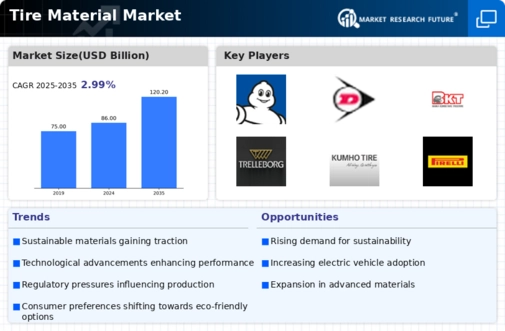Sustainability in Material Selection
The Tire Material Market Industry is increasingly influenced by the demand for sustainable materials. As consumers become more environmentally conscious, manufacturers are compelled to adopt eco-friendly materials in tire production. This shift not only addresses consumer preferences but also aligns with regulatory pressures aimed at reducing carbon footprints. For instance, the use of natural rubber and recycled materials is gaining traction, potentially leading to a market growth rate of approximately 5% annually. Furthermore, companies that prioritize sustainability may enhance their brand image, thereby attracting a broader customer base. The integration of sustainable practices in the Tire Material Market Industry is likely to drive innovation and create new opportunities for growth.
Rising Demand for High-Performance Tires
The demand for high-performance tires is a significant driver in the Tire Material Market Industry. As consumers seek enhanced driving experiences, there is an increasing preference for tires that offer superior handling, grip, and longevity. This trend is particularly evident in the sports and luxury vehicle segments, where performance is paramount. The Tire Material Market Industry is projected to grow by approximately 5% as manufacturers respond to this demand by developing innovative tire materials that enhance performance characteristics. Additionally, the growing popularity of motorsports and recreational driving is likely to further fuel this demand, creating new opportunities for manufacturers in the Tire Material Market Industry.
Regulatory Compliance and Safety Standards
Regulatory compliance is a critical driver in the Tire Material Market Industry. Governments worldwide are implementing stringent safety standards and regulations aimed at improving tire performance and reducing environmental impact. Compliance with these regulations often necessitates the use of advanced materials and manufacturing processes, which can increase production costs but also enhance product quality. The Tire Material Market Industry may experience a shift towards higher-quality materials that meet these standards, potentially leading to a market growth rate of around 4% annually. Manufacturers that proactively adapt to these regulations are likely to gain a competitive edge, thereby influencing market trends.
Adaptation to Electric Vehicle Requirements
The rise of electric vehicles (EVs) is significantly impacting the Tire Material Market Industry. As EVs become more mainstream, there is a growing need for specialized tires that can accommodate their unique performance characteristics. Tires designed for electric vehicles must support higher torque and provide lower rolling resistance to maximize battery efficiency. This adaptation could lead to a projected market growth of approximately 7% as manufacturers innovate to meet these requirements. Furthermore, the Tire Material Market Industry is likely to see increased collaboration between tire manufacturers and automotive companies to develop tailored solutions for EVs, thereby enhancing market dynamics.
Technological Advancements in Tire Performance
Technological advancements play a pivotal role in shaping the Tire Material Market Industry. Innovations in material science have led to the development of high-performance tires that offer improved durability, fuel efficiency, and safety. For example, the introduction of advanced polymers and composite materials has enhanced tire performance metrics, which could result in a market expansion of around 6% over the next few years. Additionally, the integration of smart technologies, such as sensors for monitoring tire pressure and wear, is becoming more prevalent. These advancements not only improve the overall driving experience but also contribute to the longevity of tires, thereby influencing purchasing decisions in the Tire Material Market Industry.

















Leave a Comment